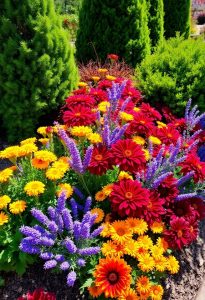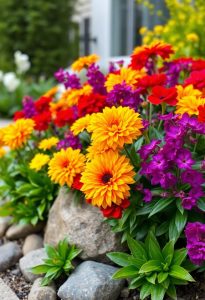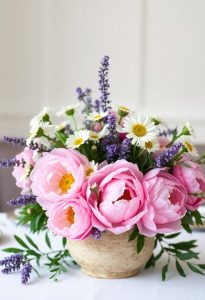Looking to brighten up your garden while saving on that water bill? Try these 7 stunning drought-tolerant flowers! Start with vibrant Lavender for a calming scent, then add bold Echinacea and cheerful Black-Eyed Susans. Sedum will bring lovely succulents, while Agave adds a striking, low-maintenance touch. Don’t forget Salvia and Yarrow for a splash of color! Each flower not only beautifies but also thrives in the heat. Curious about how to care for them? Keep going!
Important Highlights
- Consider Lavender for its calming scent, vibrant purple color, and ability to thrive in bright sunlight with minimal watering once established.
- Echinacea, or Coneflower, offers vibrant blooms that withstand heat and attract pollinators, making it ideal for a lively garden.
- Sedum features succulent flowers that require minimal care and watering, perfect for sunny spots and sustainable gardening practices.
- Black-Eyed Susan adds cheerful color and handles drought well, thriving in full sun and well-drained soil.
- Agave is a stunning, low-maintenance option that thrives on neglect, enhancing garden resilience with its drought tolerance and unique appearance.
Lavender
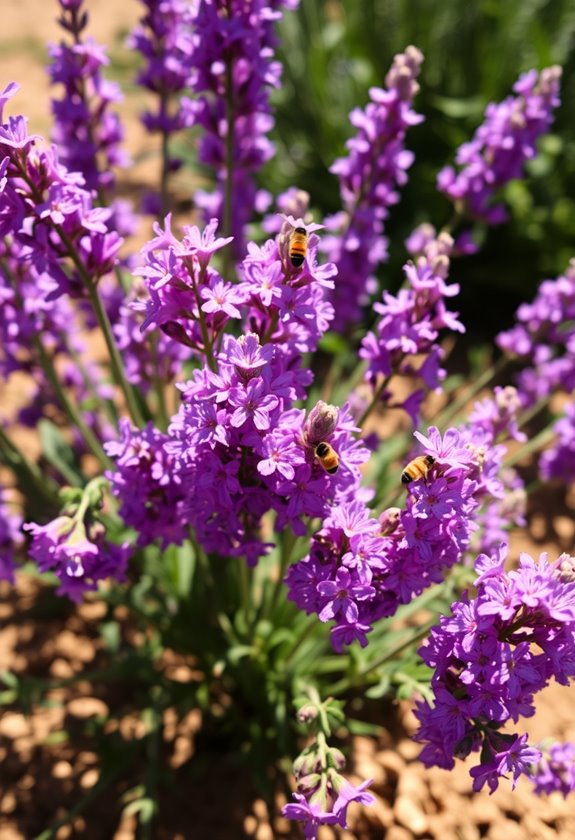
Ah, lavender! Who doesn’t love its calming scent and vibrant purple hues? Planting lavender is a delightful way to guarantee your garden thrives, even during dry spells. You’ll find it’s not just stunning; it’s super easy to care for! Here’s the scoop:
- Sunlight: Lavender loves the sun, so pick a bright spot.
- Soil: Well-drained soil is a must; nobody likes soggy roots!
- Watering: Once established, it needs little water—just enough to get it going.
Trust me, your garden will thank you! Plus, you might just attract some lovely butterflies! Who doesn’t want that? Additionally, it thrives best in well-drained, nutrient-rich soil, ensuring optimal growth and resilience against drought.
Echinacea (Coneflower)
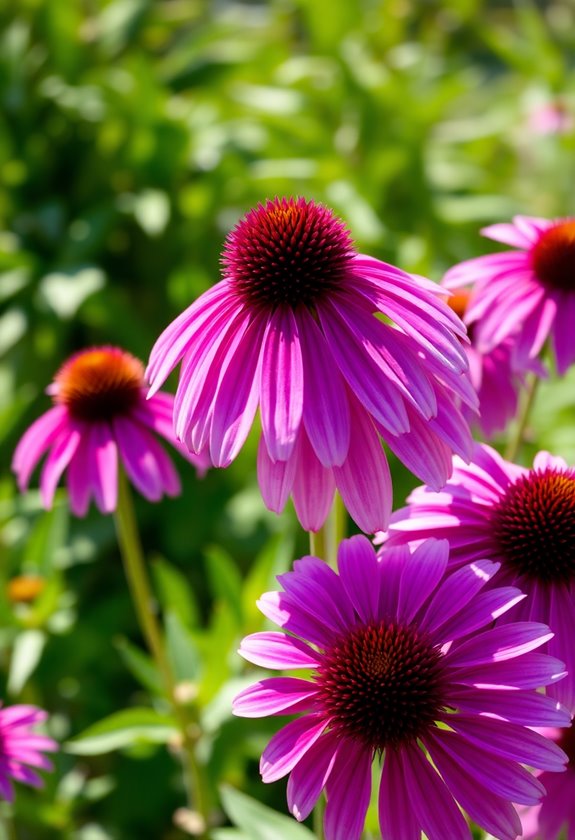
When you think of vibrant garden blooms that can withstand the heat, Echinacea, commonly known as coneflower, surely comes to mind! These lovely flowers not only brighten your garden but also thrive in dry conditions. Plus, they’re a magnet for butterflies! Here are three reasons to choose Echinacea:
- Drought-Resistant: They need minimal water once established.
- Pollinator-Friendly: Attracts bees and butterflies, making your garden lively.
- Low Maintenance: They require little care, so you can enjoy more time relaxing! Additionally, Echinacea can be a vital part of attracting pollinators in your garden, enhancing biodiversity, and supporting local wildlife.
Sedum
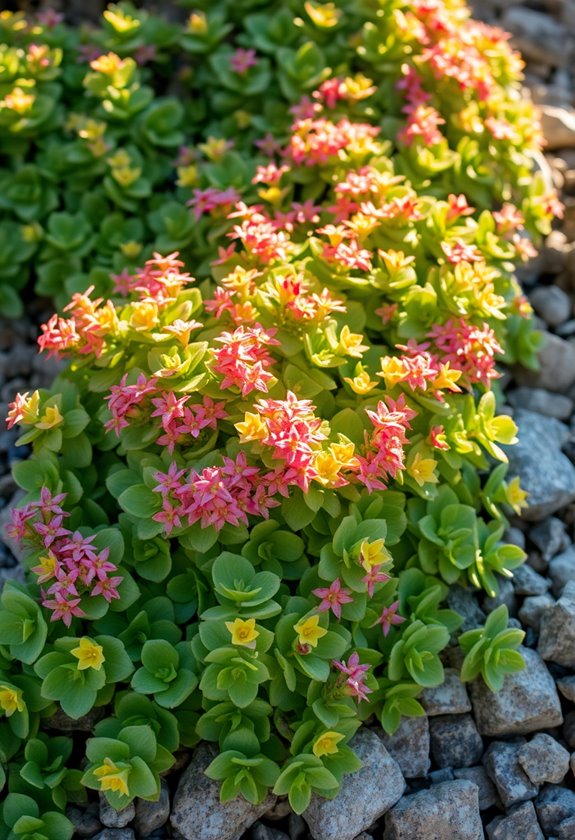
After enjoying the beauty of Echinacea in your garden, let’s explore another fantastic flower that thrives in dry conditions: Sedum. These succulent beauties are a gardener’s dream! They come in various colors and shapes, making your garden pop with life. Plus, they’re super easy to care for!
Here are some tips to grow Sedum safely:
- Choose a sunny spot.
- Water sparingly.
- Watch for pests.
You’ll love how these flowers can withstand harsh conditions. Imagine a vibrant garden with minimal effort—sounds great, right? Give Sedum a try, and watch your garden flourish! Additionally, Sedum’s ability to thrive in drought-tolerant conditions makes it an ideal choice for sustainable gardening practices.
Black-Eyed Susan

Bright and cheerful, Black-Eyed Susans are like little bursts of sunshine in your garden! These hardy flowers can handle drought, making them perfect for your outdoor space. Plus, they attract butterflies—who doesn’t love a garden buzzing with life? You’ll appreciate how easy they are to grow! Here are three tips to get you started:
- Soil: Maintain well-drained soil for healthy roots.
- Sunlight: Plant them in full sun for vibrant blooms.
- Watering: Water them sparingly; they prefer dry spells!
With these tips, you’ll enjoy a colorful garden that’s both beautiful and safe for all! Additionally, incorporating weather-resistant materials can further enhance your garden’s durability and aesthetic appeal.
Agave
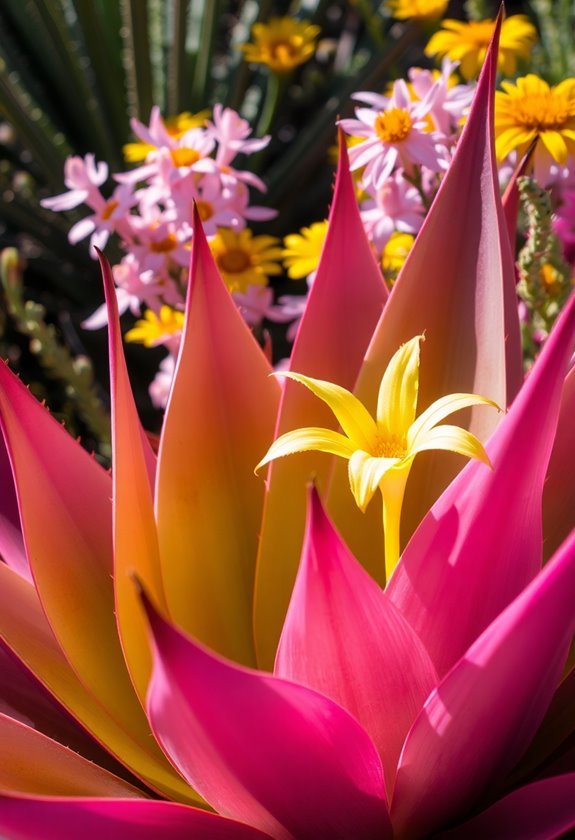
If you’re looking for a stunning addition to your garden that practically thrives on neglect, Agave might just be your new best friend! These hardy succulents come in various shapes and sizes, making them perfect for any garden style. Plus, they’re low-maintenance and drought-tolerant—ideal if you’re busy or forgetful about watering.
Here are a few tips to get started:
- Plant them in well-draining soil.
- Position them in full sunlight for maximum growth.
- Watch out! While beautiful, some Agave species have sharp edges. Investing in high-quality materials can enhance the overall resilience of your garden.
With Agave, you’ll enjoy a striking, resilient garden without the fuss!
Salvia
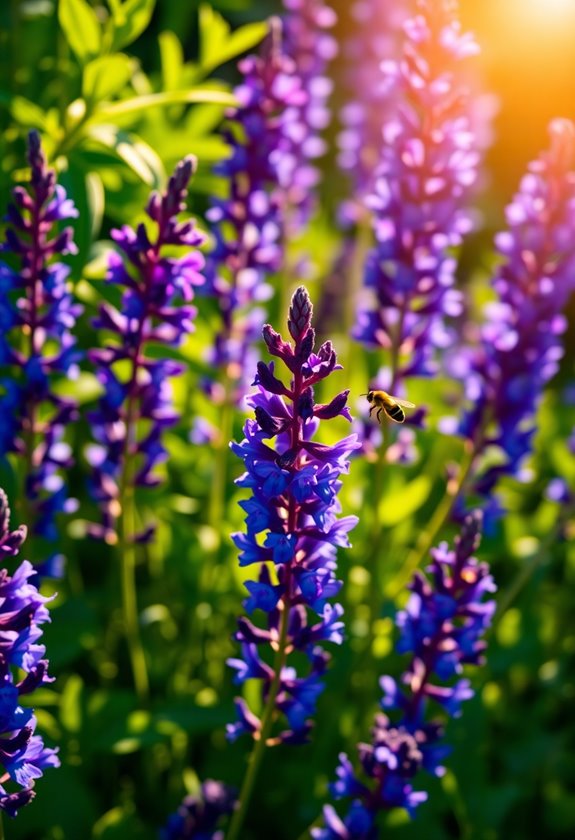
Imagine stepping into your garden and being greeted by a vibrant display of colors and scents—Salvia is your ticket to that delightful experience! These drought-tolerant beauties not only thrive in dry conditions but also attract pollinators, making your garden a bustling haven. Here’s why you’ll love them:
- Variety: With species ranging from deep blues to fiery reds, you can mix and match for a stunning effect.
- Low Maintenance: Once established, Salvia requires minimal watering—perfect for busy gardeners!
- Long Bloom Time: Enjoy their enchanting blooms from spring through fall!
Yarrow
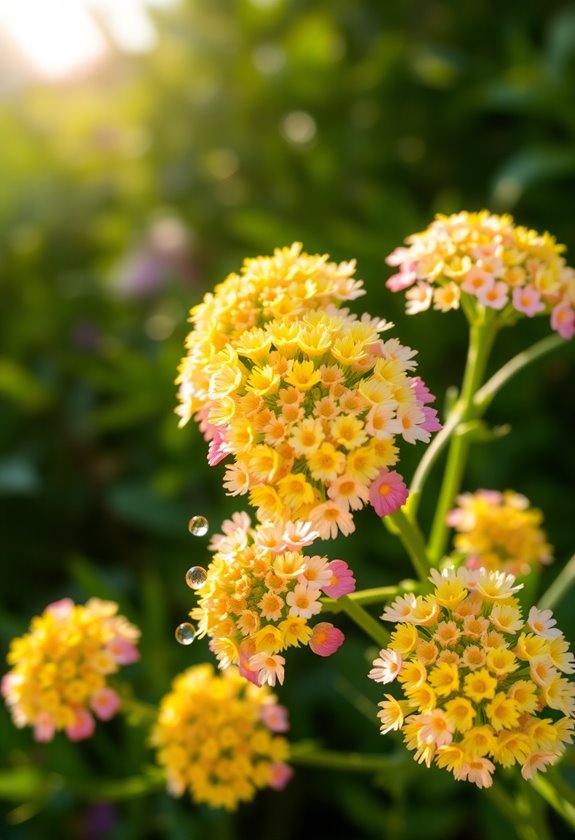
While you might think of flowers as delicate and needy, yarrow is here to prove that toughness can be beautiful! This hardy plant thrives in dry conditions, making it perfect for your garden. Its feathery leaves and vibrant clusters of small flowers bring a burst of color, attracting butterflies and bees. Plus, yarrow’s drought tolerance means you won’t be constantly watering it—how great is that?
Here are some quick tips:
- Plant in well-drained soil.
- Space them about 12 inches apart for airflow.
- Deadhead spent blooms to encourage more flowers.
Why not give Yarrow a try? You’ll love its resilience!
Frequently Asked Questions
How Do Drought-Tolerant Flowers Impact Local Wildlife?
Drought-tolerant flowers really boost local wildlife! When you plant these beauties, you’re creating a welcoming environment for bees, butterflies, and even birds. They provide essential nectar and habitats without needing too much water. Have you ever noticed how busy the garden gets with these plants? It’s like a wildlife party! So, not only do you get a stunning garden, but you also help support the ecosystem. Isn’t that something to celebrate?
Can I Grow These Flowers in Containers?
Absolutely, you can grow drought-tolerant flowers in containers! It’s a fantastic way to brighten up your space while conserving water. Just make sure your pots have good drainage and use quality potting mix. You’ll want to pick flowers that thrive in your climate. For example, succulents and lavender are perfect choices. Plus, don’t forget to arrange them in a way that catches the eye! Isn’t gardening just the best? Happy planting!
What Is the Best Soil Type for Drought-Tolerant Flowers?
Have you ever tried growing flowers in sandy soil? It can be a game-changer! For drought-tolerant flowers, well-draining soil is key. A mix of sandy soil and organic matter, like compost, works wonders. It keeps roots healthy while preventing rot. Don’t forget to check pH levels—most drought-tolerant plants prefer slightly acidic to neutral soil. So, are you ready to dig in? Your garden will thank you for it! Happy planting!
How Often Should I Water These Plants After Establishment?
Once you’ve established your drought-tolerant plants, you shouldn’t water them too often. Generally, watering once every two weeks works well, but don’t forget to check the soil! If it feels dry a couple of inches down, give ’em a drink. Remember, overwatering can be just as harmful. It’s like treating them to a spa day—too much pampering can spoil the fun! Keep an eye on the weather, and adjust as needed!
Are These Flowers Suitable for Sandy or Rocky Soil?
Absolutely, those flowers can thrive in sandy or rocky soil! They’ve got this amazing ability to adapt, which makes them perfect for challenging conditions. Just think about it: their roots dig deep, searching for water and nutrients. If you’ve got sandy or rocky spots, consider adding organic matter to help retain moisture. Have you seen how resilient they are in tough environments? It’s like they’re little champions of the garden! Isn’t that inspiring?


